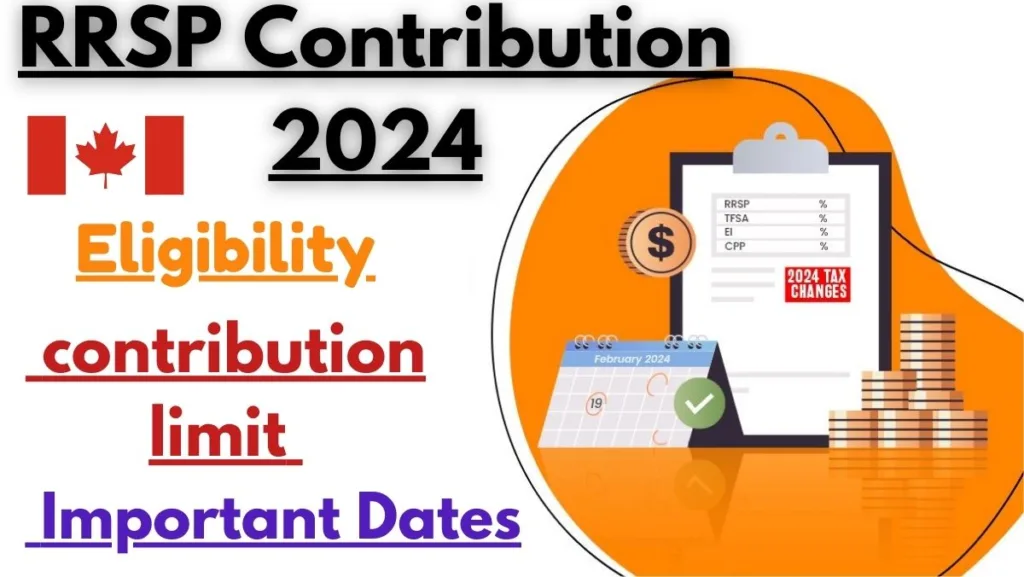RRSP Contribution 2024: In Canada, the Canadian government, in collaboration with the Canada Revenue Agency, has introduced the RRSP Contribution 2024. This retirement savings plan offers a valuable opportunity for Canadian citizens to prepare for their future, with various benefits associated with RRSP contributions in 2024. Individuals in Canada can conveniently make contributions by establishing an RRSP account through their financial institution, such as banks, and depositing funds up to the RRSP Contribution 2024 limit.
This process involves reviewing the RRSP Contribution 2024 eligibility criteria and other relevant information outlined in the Registered Retirement Savings Plan Eligibility 2024, as communicated by the Canada Revenue Agency. The CRA regularly updates information regarding the benefits of RRSP contributions in 2024 on the official website www.canada.ca.
Registered Retirement Savings Plan (RRSP Contribution 2024)
A Registered Retirement Savings Plan (RRSP Contribution 2024) is a special investment account that Canadians can use to save for their retirement. It offers two main advantages: it helps lower your taxable income in the short term and allows you to defer taxes on any investment gains until you withdraw the funds. When you RRSP Contribution 2024, you can deduct the amount from your annual income, which means you pay less tax.
This effectively lowers your overall tax rate. Furthermore, any profits you make within your RRSP are not taxed until you take the money out. This means that your investments can grow tax-free over time. It’s important to note that RRSPs have a limit on how much you can RRSP Contribution 2024 each year.
Eligibility for RRSP Contribution 2024
The CRA has made available the Registered Retirement Savings Plan Eligibility 2024 on their official website www.canada.ca, in addition to the announcement.
- There is no minimum age requirement to open an RRSP account, but the bank may ask that the account holder be at least 18 years old.
- Applicants can RRSP Contribution 2024 to the plan until they turn 71, as long as they are Canadian permanent residents who have earned income and filed tax returns on time.
- The amount and age for contributions may vary depending on the individual and their situation, to ensure that the investment plan is started at an appropriate time.
- Starting early can lead to more benefits from compound interest based on the amount and time of investment.
Advantages of RRSP Contribution 2024
The RRSP offers many advantages to investors. You can find all the information on the official CRA website at www.canada.ca. Below, we have outlined the RRSP Contribution Benefits 2024 to give our readers an idea of the perks of this investment.
- The money you invest is not taxed until you withdraw it from the plan, which means it’s tax deferred.
- Contributions made to this plan can be deducted from an individual’s taxes, reducing the amount of income tax they have to pay.
- You can carry forward unused RRSP contribution room from years when you earned less income, following the rules. This plan also allows investors to benefit from tax savings when they are in a higher tax bracket.
How do they figure out RRSP contribution limit?
- The Canada Revenue Agency usually calculates your yearly RRSP Contribution 2024 limit by taking into account your unused RRSP deduction room from the previous year and adding the lesser of either 18% of your earned income from the year before or the annual RRSP limit.
- Other adjustments may also be made if necessary.
- For more details, you can check out the Canada Revenue Agency website.
Withdrawal and Ownership Restrictions
- Even though you can take out money from an RRSP whenever you want, as long as it’s not locked, it’s important to know that these withdrawals are considered taxable income and you have to pay income tax on them in the year you withdraw.
- Depending on how much money you make when you withdraw, it might be better to wait until a year when you have less taxable income.
- It’s worth mentioning that you can’t keep an RRSP after December 31, 2024, of the year you turn 71.
- In that case, you have to take out all the money from the RRSP and either transfer it to a Registered Retirement Income Fund (RRIF) or use it to buy an annuity.
Contribution Date
The dates for contributing to your RRSP in 2024 have been released, and the deadline is February 29, 2024. The contribution amount for the year is set at $31,560. It’s really important to check if you’re eligible to contribute to your RRSP in 2024 so you know how much you need to pay. Making a contribution to your RRSP in 2024 is a great way to plan for your future, and there are lots of benefits and rules that you need to think about. To contribute, you’ll need to open an RRSP account with a bank or another financial institution and make sure you understand all the details and requirements.
What will happen if I contribute too much to my RRSP?
- If you contribute too much to your RRSP, you may face penalties. If you go over by $2,000 or less, you won’t be penalized, but you can’t deduct the excess amount from your taxable income.
- However, if you exceed $2,000, you may have to pay a 1 percent tax per month.
- To avoid this penalty, you can withdraw the extra amount before the end of the month it was contributed or put it into a qualifying group plan.
- If you do have to pay the tax, you must submit a T1-OVP return and pay the tax within 90 days after the end of the year with the excess contributions.
- You can request to cancel or waive the tax by providing supporting documents and showing that the excess contributions were due to a reasonable error.

